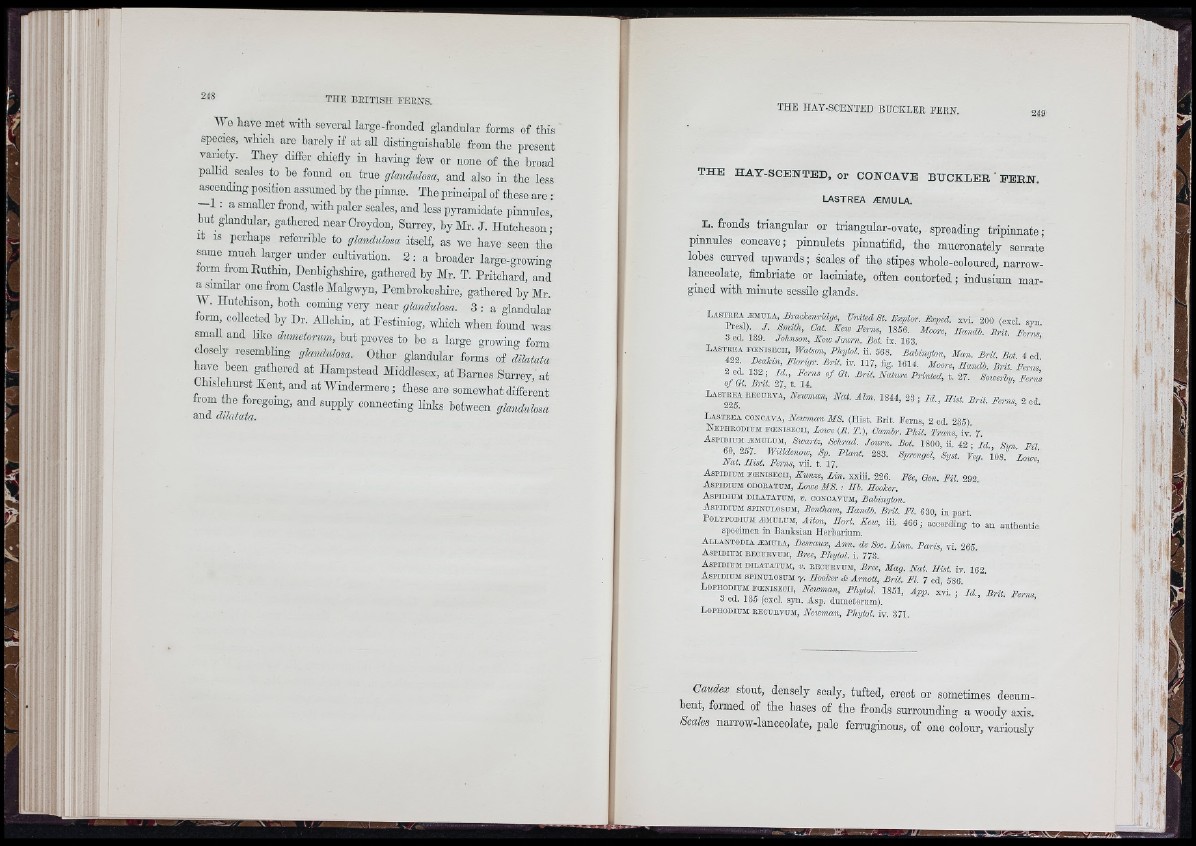
Wo havo met m th several largo-frondod glandular forms of this
spooics, which are barely if at all distinguishable from tho present
vanety. They differ chiefly in having few or none of the broad
pallid scales to be found on true glandulosa, and also in the less
ascending position assumed by the pinnæ. The principal of these aro :
—1 ; a smaher frond, ivith paler scales, and less pyramidate pinnules,
but glandular, gathered near Croydon, Surrey, by Mr. J. Hutcheson-
it IS perhaps referrible to glandulosa itself, as we have seen thé
same much larger under cultivation. 2 : a broader large-growing
torm from Euthin, Denbighshire, gathered by Mr. T. Pritchard, and
a s i i ^ a r one from Castlo Malgwyn, Pembrokeshire, gathered
W. Hutchison, both coming very near glandulosa. 3 ; a glandular
form ooUeoted by Dr. Allchin, at Festiniog, which when found was
small and hke dumetorum, but proves to be a large growing form
closely resembling glandulosa. Other glandular forms of dilatata
hare been gathered at Hampstead Middlesex, at Barnes Surrey, at
Chislehurst Kent, and at Windermere ; these are somewhat different
iiom the foregomg, and supply connecting hnks between
and dilatata.
t h e HAY-SCEHTED, or CONCAVE BUCKLER ' EERN.
l a s t r e a ÆMULA.
L. fronds triangular or triangular-OYate, spreading tripinnate ■
pinnules concave; pinnulets pinnatifid, the mucronately serrate
lobes curved upwards; scales of the stipes whole-coloured, narrow-
lanceolate, fimbriate or laoiniate, often contorted ; indusium margined
with minute sessile glands.
L a s t e e a ÆMULA, United St. Explor. Exped. xvi. 200 {excl svu
F ' ? S r it. Ee rm
3 cd. 139. Johnson, Kew J o um . Bot. ix 163 ’
L a st e e a f « h is e c i i , Watson, Phytol. ii. 568. BaUngton, Man. B rit. Bot. 4 ed
422 Deakin P lo ra r . Brit. W. 117, fig. 1614. Moore, H a n d l. BHt. Ferni,
o f Gt B r k M t . f r 27- Sowerhj, Fems
L a st e ea e e c u ey a , Newman, Nat. A im . 1844, 23 ; Id ., Hist. B rit. Fems, 2 ed.
L a st e e a concava, Newman MS. (Hist. Brit. Fems. 2 cd 235)
N e p iie o d iu m eoe n is e c i i, Lowe {It. T.), Oarnilrr. P h il. Trans, iv. 7.
1 8 0 0 - ii .’4 2 ; Id ., S yn . F il
60, 257. WÜUenow, Sp. P la n t. 283. Sprengel, Syst. Yeg. 108. Lowe,
Nat. Ilxst. Fems, v ii. t . 17. ’
A s p id ium fosn isecii, Kunze, L in . xxiii. 226. Fée, Oen. F il 292
A s p id ium odoeatum, Lowe MS. : Hb. Hoolcer.
A s p id ium d i l a t a t u m , v . c o n c a v um , Babington.
A s t id ium spin ulo sum , Bentham, Handb. Brit. FI. 630 in p a rt
PoLYPODmMiEMULUM, A ito i, Hort. Kew, iii. 466 ; according to an authentic
speciiaen in Banksian Herbarium.
A l l a n t o d i a æ m u l a , Desvaux, A n n . de Soe. Bin n . P a r is v i 26B
A s p id iu m e e c u e v u m , Bree, Phytol. i. 7 7 3 .
A s p id ium d ila ta tum , ». e e c u ev um , Bree, Mag. Na t. H is t iv 162
A s p id ium spin ulo sum 7. Hooker & Am o tt, B r it FI 7 ed 586 '
L o p h o d i u m EIENISECU, Newman, Phytel. 1851, App. xvi. ; 'i d . , Brit. F ems
3 ed. 135 (excl. syn. Asp. dumetorum).
L oph o dium kecu rv um , Newman, Phytol. iv. 371.
Caudex stout, densely scaly, tufted, erect or sometimes decumbent,
formed of the bases of the fronds surrounding a woody axis.
Seales narrow-lanceolate, pale ferruginous, of one colour, variously
■ h - d ■ Ï ^ I
'. tri' '
m
i- i H
;'-4 !
'i Lï'I
J,
(■ rii
?. i- I